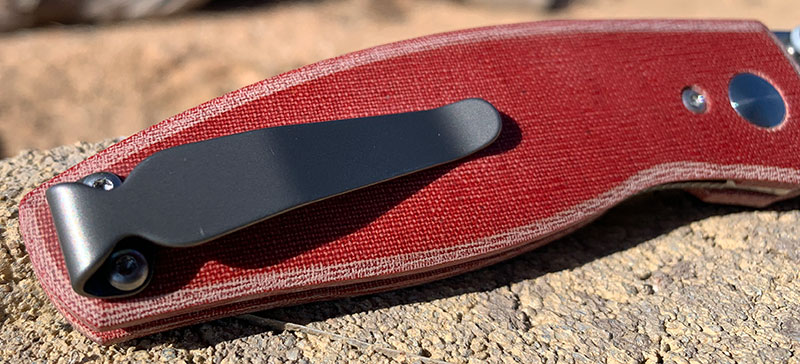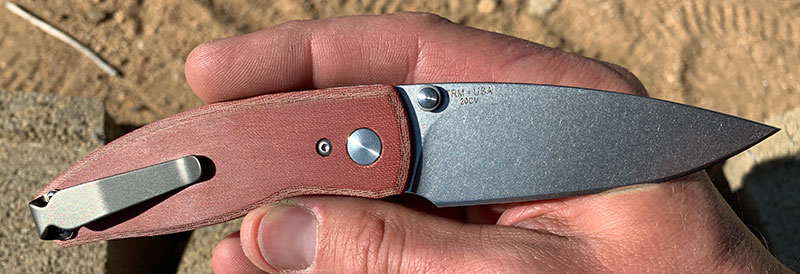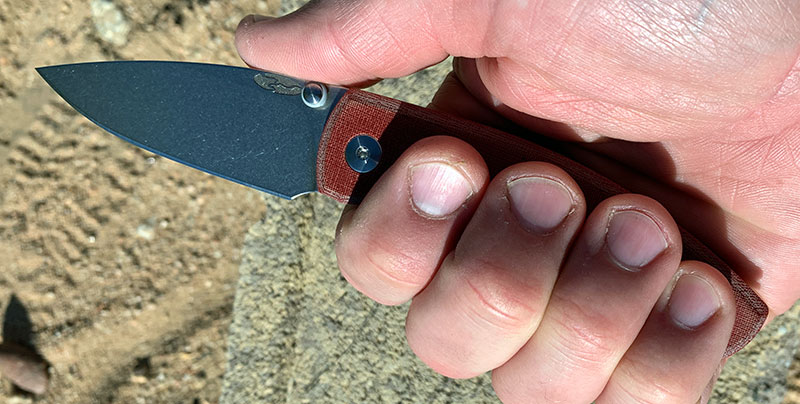We independently evaluate all recommended products and services. Any products or services put forward appear in no particular order. If you click on links we provide, we may receive compensation.
Sometimes, a particular thing just fits. Whether it’s a pair of jeans, a new car in it’s garage, or the look of a dog to its owner, some things just fit in their proverbial place. TRM (Three Rivers Manufacturing) has made a knife, that just “fits” in today’s world of pocket knives. It’s small but not tiny, well made but not overly expensive, lightweight but not too light, and works for any small EDC task you could ask of it.

And precisely where does the Neutron 2 (aka NEWtron) fit? Well, it fits in the pocket just fine, of course. But does it fit a big enough portion of the market? It should, with build materials like 20CV blade steel, handle scale options of carbon fiber, micarta, or G10, and a blade shape that’s almost universally appreciated in any normal use. Sometimes it’s hard to justify the price point of a product by build materials alone, so we have to look much closer at the execution of design, usability, and the hype in a knife with this kind of allure with scrutiny. So, let’s.
Key Specs: TRM Neutron 2
The Blade
TRM has hit another home run with this blade. Short of prying, or being somewhat too short for some users at only 3”, I don’t think I can come up with many reasons why this blade isn’t great. CPM-20CV blade steel has a reputation for being high on the list of today’s available steel composition choices, and for great reasons. Edge retention is usually one of the most desirable attributes in folding knife steels, and 20CV scores quite high for a stainless steel. And speaking of stainless, the corrosion resistance of this steel is known to be one of the better choices, of course falling short only to high nitrogen steels like LC200N.

In salt water tests, 20CV doesn’t corrode much at all, so long as the blade isn’t exposed for too many hours, or isn’t properly cleaned afterward. It’s not the steel world’s gift in toughness, but in a 2.5 ounce folder, I don’t think anyone is looking for a blade that will pry open a paint can or split a 2×4 in half. The blade’s thickness is .09”, which is ground to a nice flat profile, with a thin edge to boot. We’re in slicing territory here, if we’ve ever been.
TRM is a company that prides themselves in USA manufacturing, and USA sourced materials as much as possible. Their pride is carried over to the blade, with the lock side reading “USA” (along with “20CV” and “TRM”. Even the font is chosen wisely here, with small print, but legible elegance. To continue the small touches that make this blade worth it’s weight, is a 2-part tumbling process, using deburring and a final tumble and polish in ceramic balls. If you’ve ever seen one of TRM’s blades in the right lighting, you may have noticed the somewhat reflective sheen on the blade flats, which resembles ultra high definition TV static. It almost looks like pixels from a zoomed in view of an LCD panel. It’s unique, and encompasses TRM’s attention to detail and pride in craftsmanship in one small element.

Moving on to the blade shape, we have a scaled down version of the TRM Atom, in all the right ways (check out our review on the Atom, you can thank us later). It’s the most subtle drop point, with a gentle sweep to the belly of the edge, in a full flat grind that exudes mediocrity. And I mean that in the best possible way. It’s like looking at a car tire; it looks boring, plain, and functional over anything else. But it does what it’s supposed to, and bringing the blade to a cutting material brings all these little aspects to a climax of execution in design.
Deployment / Lockup
As with all TRM folders, we’re looking at dual titanium thumbstuds. And again, they’ve used studs with a notch around the stud, which most users have improved by adding O-rings to them. This gives the somewhat small studs much better purchase in deployment. Sans O-rings, the studs still work well, and give good purchase whether using the thumb or middle finger to flick open the blade. If I could choose any opening method as my favorite, it would be an opening hole on every knife. But there are advantages to utilizing thumb studs, such as a blade less prone to breakage than one with a larger hole, and a more streamlined blade since the studs take up much less room on the blade.

The Neutron 2 has a well tuned detent for keeping the blade closed when pocketed or in travel, and allows the blade to snap open to it’s locked position with authority. Or, with as much authority as there can be on a 3” blade at .09”. Once in it’s open position, the Neutron is surprisingly solid. Using the same slim liners on some of their other folders, the liner lock on the Neutron 2 is slim yet solid. I’ll admit to the mental pause it gives me to use a knife with such thin liners, but I’ll also admit that it really doesn’t matter. The slim, streamlined liner also has a soft touch of jimping to it, to give the thumb just enough purchase to push the lock out of the way, and send the blade home back to it’s closed position. It’s a nice, swift deployment, that’s smooth, and void of any issues.
Features, Fit and Finish
Why are there three Back To The Future movies? Why is there a new iPhone every year? Why do car manufacturers make a new iteration of their flagship models every year or two? Well, as much as one who makes things takes pride in the product, we can all agree that there’s always room for improvement. And, for TRM, after 2 years of making the same old Neutron, they thought, “hey, let’s make a sequel”. And they did it right. There weren’t any fatal flaws with the original Neutron, but with the Neutron 2 we get a few welcome additions that breathe new life into the quiet little folder that could.

One of the biggest aftermarket folding knife products is the infamous deep carry clip. Whether you want your knife to hide better in the pocket for discreet carry, or just like the idea of the knife handle tucked away further in the pocket to avoid accidental snags, the deep carry clip is a feature that most EDC afficionados appreciate. So with the Neutron 2, TRM went ahead and put a deep carry clip on the knife from the factory. They seem to have taken the same care and thought with the clip as they have with the rest of the knife, since I couldn’t find any discernable hot spots in use, and the retention seemed to be right in the sweet spot to allow quick and easy extraction from the pocket, without sacrificing too much movement once the knife was seated back in place for carry. And, wait for it… TRM made sure that the clip is backward compatible, so the standard clip from the original Neutron fits the second gen, and vice versa.
The second touch of class TRM decided to include on the Neutron 2 is nested liners. For clarity, this means that the liners that hold the knife together before the handle scales go in place sit within the handle scales rather than sit on top of them. Functionally, this makes no real difference. But where it does make a difference is in perceived quality and overall thickness. The difference in thickness between the two generations is negligible, with the original Neutron at 0.32” thick, and the second gen at 0.36” thick. So yes, the Neutron 2 is thicker than the Neutron, but you’d never know just by holding them both side by side. But looking at the knife with a trained eye will give the perception of a slightly higher quality build compared to the original variant.

And yes, TRM still has retained one of their more desirable features; the ability to change handle scales on a whim. With the knife being completely assembled at the point of the liners, the scales are removable with 2 screws on either side of the knife, and the pocket clip. TRM has made tons of different types of handle scales for their knives, and the Neutron 2 is no exception. A new outfit every day of the week to match your shoes? No problem, TRM has got you covered. Need more grip with carbon fiber? You got it. Desire some micarta in place of that G10? Sure, you can do that too. I dare to say many Neutron 2 owners have more than one or two sets of handle scales at their disposal, it’s a fun and easy way to change the look and feel of your knife with ease.
The fit and finish of TRM’s knives seem to be consistent in quality. All edges of the blade and scales, as well as the liners, are chamfered and smooth. The screw hardware is on the small side, but that’s to be expected on such a small knife, especially considering knives like the Microtech Socom Elite use nearly the same sized hardware. The fitment between the scales and liners, blade centering, and lockup are are rock solid in this very pocket friendly folder. It’s always a pleasure to handle a knife that has so much care taken in it’s execution of manufacturing.
Field Test
While I enjoyed my time in using the Neutron 2 for review, I did find the knife to feel short in the hand, primarily in the handle length. When you buy a knife with this profile, it’s assumed (or at least it should be) that the knife isn’t going to be used for any huge cutting tasks, or for long duration marathon cardboard chores. But even then, it does feel a bit too slim and small for my liking. It’s hard to get a grip on the knife with the entire thickness of the handle around 3/8”. The handle is 4” long, but the shape of the handle isn’t really conducive to ergonomic expectations.

I wasn’t going to test this particular knife to see if I could replicate this issue, but I did read a couple accounts of users gripping the knife tightly, but not overly tight, and having the liners bend inward toward the center of the handle scales. TRM has one of the most active social media relationships with users, and will almost always fix something if it’s brought to their attention, so I wouldn’t be too worried about this particular reported issue. But, once again, I had pause when going to do certain chores with the Neutron 2, like cutting double walled cardboard to fit into the trash can.
Aside from it’s short-comings, the Neutron 2 is hard to dislike. Cutting up some fruit for the kids’ lunch, opening standard packaging, or a quick venture out of the pocket for any EDC task is going to be satisfactory for almost any user. Breaking down a few quick boxes from the garage was no problem, and even with the smaller, shorter handle found on this model, I didn’t have any real ergonomic gripes to speak of. And carrying the Neutron 2 was one of the better knives in pocket, comparing similarly to the Benchmade Bugout in profile and weight. The pocket clip seems to hold well for retention, and the finish on the scales allows the knife to slide in and out of the pocket quite easily.
Alternatives
All these knives available at BladeHQ.
Three Rivers Manufacturing has a few models that they switch production runs between, including the Neutron 2, Atom, Atlas, Nerd, and Shadow. All of their knives share quite similar materials and build quality, so much of their lineup compares aptly with one another. But to branch out away from a single brand, the Benchmade Bugout is quite the alternative to the Neutron. The Bugout has picked up tons of traction since it’s release a couple years ago, so it’s one that many EDC fans are already very familiar with.
The Bugout is close in weight (1.9 ounces vs the Neutron 2 at 2.5 ounces), similar cutting edge lengths (3” on the Bugout, and 2.875 on the Neutron), and flat ground, drop point blades on both. The Bugout is widely available on most any online retailer’s website, while the Neutron seems to be harder to find on a regular basis as TRM is a much smaller company. The Bugout is cheaper, around $25 less than the Neutron 2, but the build materials are definitely much lower end on the Bugout, with FRN handle scales, a partial liner, and S30V blade steel. Still quite the capable knife, the Bugout comes in tons of variants, and is also in Benchmade’s custom shop now, with the ability to be made with different materials and colors, as well as blade steel materials and finishes.
And Spyderco, with their evergreen, ever popular Para 3, has quite the match to go head to head with the Neutron 2. A 3” blade length that’s flat ground, and a handle that’s just about the same length, make the Para 3 and Newtron look very similar on paper, and maybe even at first glance in person. But, the Para 3 is about a full ounce heavier, is nearly half an inch thick in the handle, has very tactile, nearly abrasive scales, and an opening hole instead of thumb studs for deployment.

It does use a compression lock, which varies from a liner lock in the means of how the lock engages, but it does share the commonality with the Neutron in the sense that it’s using a liner to lock the blade in place. The Para 3 has made it’s place in Spyderco’s lineup, and in the collection of just about every user and collector of folders on the planet. The Para 3 is also around $25 cheaper than the Neutron 2, but has some variants that break the line over the price point of the Neutron. The Para 3 is undoubtedly a more stout knife in every way than it’s competitor here, but it has enough similarities that it’s worth pitting side by side with TRM’s mid sized folder.
Conclusion
Sometimes it’s the lack of perceived intricacy that allows simplicity to shine. And that is precisely where TRM’s NEWtron fits. It may not be the most rugged offering in this price range, or the most hand filling option for a 3” blade. But it does fit the bill for an easy to carry EDC folder, with high quality materials, good heat treat, tons of scale options, and a blade that’s nearly perfect for daily tasks. TRM, being a small business, has the disadvantage of having a shortage of knives on a regular basis. They tend to sell out very quickly, leaving most of us to the secondary market for a chance at one of their knives. They try to make up for it, in being close to their users and very friendly to just about anyone who approaches them, but it’s hard to recommend knives that are regularly unattainable.
It’s hard to blade them for it, though. I for one would rather have a high quality piece of hardware from a USA company that cares about their product, than one that’s overlooked in quality control and just trying to get to the next knife. So the Neutron 2 seems to be a mascot of sorts to it’s manufacturing company, as it parallels in terms of being a small knife to a small company, that has a lot of care taken in it’s manufacturing, just as the company takes care in their user’s community and feedback.
- Lightweight, easily customizable, quality build materials, great heat treat, high quality build
- Very hard to attain, thin handle, not as versatile as competitors with lack of durability
TRM Neutron 2
Quality/Performance - 82%
Value for Money - 76%
79%
If you can snag one, the Neutron 2 is a great easy to carry EDC folder, with high quality materials and an excellent blade for everyday tasks.





